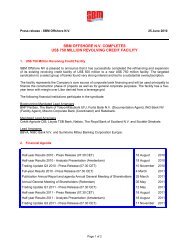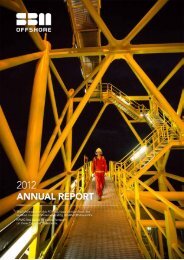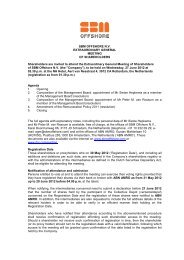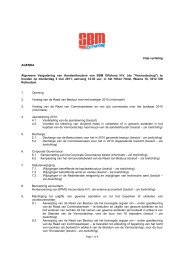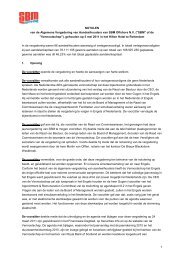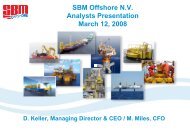Annual Report 2010 - SBM Offshore
Annual Report 2010 - SBM Offshore
Annual Report 2010 - SBM Offshore
You also want an ePaper? Increase the reach of your titles
YUMPU automatically turns print PDFs into web optimized ePapers that Google loves.
<strong>Report</strong> of the Board of Management<br />
with the lessons learned being incorporated into the<br />
Emergency Contingency Plan.<br />
Payment risk<br />
Before the acceptance of each major contract, a credit<br />
review and a detailed review of the terms and conditions<br />
are carried out by experienced financial, risk, legal<br />
and commercial professionals. Bank and/or parent<br />
company guarantees are negotiated with customers,<br />
and if doubts remain as to the financial strength of the<br />
customer, payments due in respect of supply contracts<br />
are covered by Letters of Credit. Payment risks on<br />
banks and insurance companies are managed within<br />
reasonable credit limits adjusted to account for credit<br />
ratings of the institutions.<br />
Lease risk<br />
When making a proposal to lease a floating facility to<br />
a client, ten main risk factors must be evaluated:<br />
• client credit reliability and exposure limits;<br />
• country stability, politics and exposure limits;<br />
• health, safety and security;<br />
• environmental conditions;<br />
• contractual rights and obligations;<br />
• performance criteria;<br />
• finance availability;<br />
• insurance availability;<br />
• tax exposure;<br />
• residual value exposure.<br />
The Company reduces its exposure by a package of<br />
means including guarantees, limited recourse financing,<br />
interest rate swaps and insurance. When necessary,<br />
finance structures may be arranged prior to bidding.<br />
Beyond the traditional fixed day-rate lease model,<br />
there is an increasing tendency for clients to look to<br />
contractors to share risk, sometimes by linking a part<br />
of the revenues to production throughput or even to<br />
the oil price. A very careful approach to such proposals<br />
is taken, firstly by capping the risk to an acceptable<br />
level in a worst-case scenario and secondly by ensuring<br />
an appropriate balance between the potential risks<br />
and rewards. The Company has currently only one<br />
lease contract (DeepDraft Semi® Thunder Hawk for<br />
Murphy) where revenues are partially linked to production<br />
throughput, with a second project (Tubular Bells,<br />
for Hess and partners) currently in the early engineering<br />
92 <strong>SBM</strong> <strong>Offshore</strong> – <strong>Annual</strong> <strong>Report</strong> <strong>2010</strong><br />
phase under a Letter of Intent arrangement, to be confirmed<br />
by full project sanction later in 2011.<br />
Residual value risk relates to the portion of the unit<br />
which is not amortised over the initial guaranteed lease<br />
period. Deciding on that value involves taking a view<br />
on the likelihood of the lease being extended, the technical<br />
reusability of the unit and the expected market<br />
demand. Correctly estimating the residual value is an<br />
important component of the lease rate calculation. A<br />
cautious approach is however taken when establishing<br />
this key parameter and the residual book value is calculated<br />
based on an economic life less than the design<br />
life and below the estimated future market value.<br />
Experience shows that almost all lease contracts have<br />
been extended and so far no unit has been redelivered<br />
to the Company with a market value lower than the<br />
residual book value.<br />
Operating cost risk<br />
The <strong>SBM</strong> <strong>Offshore</strong> model operating contract is based<br />
on a reimbursable cost principle and an inflation<br />
adjusted fixed fee covering the Company’s production<br />
management costs. The bidding rules of some clients<br />
such as Petrobras require a fixed price contract and in<br />
such cases the Company is exposed to cost inflation<br />
over the long term. Such contracts are now subject<br />
to a formula compensating for inflation although the<br />
Company remains exposed to shortfalls between<br />
revenue escalation under the formula and actual cost<br />
inflation. The Company takes a conservative approach<br />
in its lease pricing but some risk remains.<br />
Political risk<br />
The Company evaluates overall political and country<br />
risk in discussions with banks and does not hold assets<br />
in countries where acceptable insurance cover is unavailable.<br />
The Company is exposed to revenue risks<br />
from Brazil, Angola and other countries and risks are<br />
reduced by a combination of solid contracting parties<br />
or parent guarantee structures and insurance. Overall<br />
country risk is evaluated objectively against credit limit<br />
guidelines relative to total equity. Some operations<br />
take place in regions which present identifiable security<br />
risks and even terrorism. In such countries the risks are<br />
assessed, protection measures are put in place and<br />
crisis resolution plans established.



